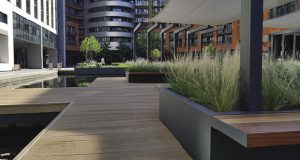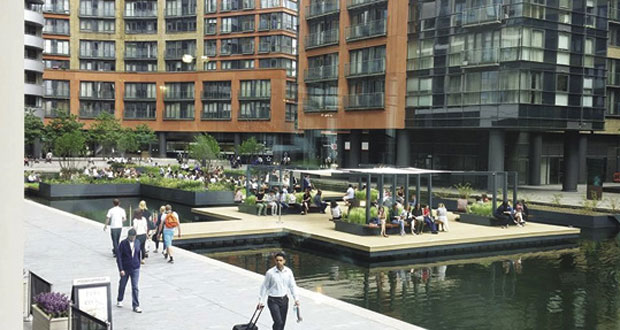Sustainable drainage systems (SuDS) can be an asset for your business as well as benefitting the environment, says Caroline Birdsall, UK and Ireland Director of Marketing for The Millboard Company
Stories about the impacts of prolonged droughts and sudden flood events are becoming ever more frequent in the news media. The growing problems that a lack or excess of water can cause have led scientists to look at the causes and potential solutions.
Beyond the well-known impacts of climate change, other human impacts on the environment are also at play, not least the way we have concreted over much of the land on which our cities are based and installed systems of pipes and sewers to channel surface water away. While these systems initially served us well as our societies industrialised and urbanised, we have reached the point where their limitations are now being exposed. A report issued jointly by the Mayor of London’s office and Transport for London in 2016 stated: “London’s existing network of sewers and drains is at or near capacity in many areas and the issue is exacerbated by a rapidly increasing population.” This story reflects the experience of a growing number of our towns and cities.
The consequence is that valuable water is allowed to run away when it could be stored and, in times of excess rainfall, our towns’ and cities’ hard surfaces leave nowhere for the water to go when their drains are full.
This is where sustainable drainage systems come in. Sustainable drainage systems – commonly abbreviated to SuDS seek to control the flow of water more efficiently to mitigate the effects of both droughts and floods. The more entities that use SuDS, the greater their combined effect, so businesses have a big part to play – and far from adding costs, it can actually deliver savings over the long term.
It can also improve how others perceive an organisation. Customers and investors are increasingly factoring how companies interact with their environments into their buying decisions. Demonstrating sustainability is an asset, and SuDS can make a big contribution.
UTILISING SUDS
SuDS come in a variety of forms rather than being a one-size-fits-all way of changing the fabric of your estate. Some elements are easier to factor into buildings when they are at the planning stage, but many can be retrofitted to existing buildings and their surroundings.
Rain capture systems, including green roofs and walls, can be used to retain water and route it into storage tanks, which ideally should be situated below ground to avoid evaporation. This water can then be used to provide water for washing and toilet facilities – sometimes even drinking water – within the building, or to irrigate planting outside, thus reducing the demand for mains water.
While the more complex systems can be too expensive to retrofit in many instances, there are many other SuDS elements that are simple to adopt for most businesses. It is easy to install rain planters to capture water from existing downpipes, and trees can be planted into self-contained pits that will not only prevent roots undermining structures but also act as reservoirs for holding water which might otherwise collect on hard surfaces and contribute to local flooding.
Those hard surfaces could also in many instances also be swapped for permeable ones. Staff rest areas will often benefit aesthetically if concrete and tarmac are replaced with decking, and nowadays there are plenty of alternatives to wood that don’t decay or become slippery in wet weather. Modern high grade composite materials are themselves impervious to water but allow it to drain between boards and be absorbed by the ground beneath. At the extreme end of the scale, their resistance to water even allows for construction directly over water. For example, the Floating Pocket Park in Paddington, West London, was constructed using Millboard decking to create a leisure area that vastly improved the local environment and amenities. It serves to show that using similar materials to provide usable surfaces that will permit natural water flows without themselves being adversely affected is eminently practicable.
SUDS DELIVER BENEFITS ON SEVERAL LEVELS
- SuDS systems have few or no moving parts and typically require little ongoing maintenance.
- When integrated into buildings’ water supplies they reduce reliance on mains water so can actually save money.
- They can improve spaces visually, offering attractive venues in which to hold meetings and events, and help to enhance your workforce’s wellbeing.
- They demonstrate your business’ commitment to play a responsible part in the local community through measures which will help mitigate flooding and droughts.
- Implementing SuDS both improves your company’s sustainability and provides a tangible demonstration of it to its investors and customers.
 Given its many advantages, we can expect to see the SuDS philosophy become the norm rather than the exception within the next few years. Already some planning schemes are approved only if they have SuDS measures built in, and they may become mandatory in law before long. It makes sense to be ahead of the curve and gain goodwill for installing them while they remain voluntary, as well as enjoying the savings they can deliver sooner rather than later.
Given its many advantages, we can expect to see the SuDS philosophy become the norm rather than the exception within the next few years. Already some planning schemes are approved only if they have SuDS measures built in, and they may become mandatory in law before long. It makes sense to be ahead of the curve and gain goodwill for installing them while they remain voluntary, as well as enjoying the savings they can deliver sooner rather than later.





